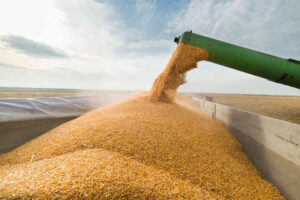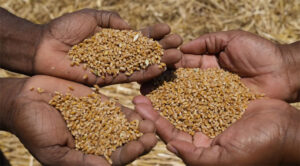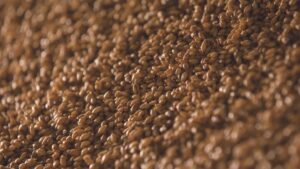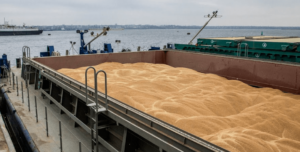
In July-September this year, the cargo turnover of the port of Kolobrzeg increased by 52% due to the resumption of transshipment of Ukrainian agricultural products, the Polish edition of Rynek Infrastruktury reports.
According to the report, Kolobrzeg was not previously included in the Polish government’s resolution on the transit of Ukrainian grain. In the third quarter, the port resumed accepting Ukrainian agricultural products, which helped increase cargo turnover.
In the third quarter, the Polish port handled more than 73 thousand tons of cargo, which is 52% more than in the same period of 2022, when 48 thousand tons were handled. The cargo included grain, logs, limestone, pellets and fertilizers. Grain accounts for half of the transshipment. Among the grains transshipped in Kolobrzeg, corn and barley were the most common.
The port temporarily suspended operations in April this year. Back then, the Polish authorities banned imports of Ukrainian grain but allowed its transit. At first, Kolobrzeg was not on the list of ports that could handle Ukrainian grain, but later the Polish government allowed the company to handle Ukrainian cargo.
“We have demonstrated that we are unpredictable in our actions as a country, so building long-term business relations is perceived as risky, as one decree can turn everything upside down”, said Artur Lievski, head of the port’s administration.
A week after the ban was imposed by the Polish government, the mistake was corrected: Kolobrzeg was included in the list of seaports through which grain can be transited from Ukraine. However, it took a long time to restore trust, and for some time no freight trains with Ukrainian products arrived in Kolobrzeg. After a three-month break, the first train with corn from Ukraine arrived at the seaport of Kolobrzeg in late July, the newspaper said.

In early October, IMC Agro Holding completed sowing of winter wheat for the 2024 harvest on 20.3 thou hectares, the company’s press service reported on Facebook.
According to the report, the warm and dry weather in September allowed IMC to sow all the planned areas with winter wheat, and the precipitation in the second decade of October helped to get friendly winter shoots.
In addition, at the end of the second decade of October, the agroholding completed threshing sunflower on an area of 32.1 thou hectares, harvesting 92.7 thou tons with an average yield of 2.9 tons/ha.
At the same time, the yield on the land in the north of Chernihiv region, which was not cultivated last year due to the occupation and the subsequent need to inspect for explosive devices, amounted to 2.2 tons/ha. On the rest of the IMC areas in Chernihiv, Sumy and Poltava regions, the sunflower yield amounted to 3.3 tons/ha.
“As for the sunflower harvest, its average yield is not a record for IMC, given the above-mentioned objective reasons, but nevertheless, the total yield and quality of sunflower give hope for its successful sale for processing,” said Oleksandr Verzhykhovsky, Chief Operating Officer of IMC.
As reported, in the 2023 season, IMC obtained a record average winter wheat yield of 7.1 tons/ha, which was the highest result in the 25 years of the agricultural holding’s operation. The company allocated 33.3 thou hectares for the crop, from which it harvested 236 thou tons of grain.
“IMC specializes in growing grains, oilseeds and milk production in Ukraine. It cultivates about 123.3 thousand hectares of land in Poltava, Chernihiv and Sumy regions. It has storage capacities of 554 thousand tons of grains and oilseeds.
In January-March 2023, IMC Agro Holding posted a net loss of $4.10 million, down 2.6 times year-on-year, largely due to higher logistics and distribution costs. The holding’s revenue increased by 11% to $41.96 million, of which exports accounted for $35.03 million. IMC’s gross profit grew 3.9 times to $8.60 million due to lower costs. Due to a twofold increase in logistics and distribution costs (up to $9.40 million), the company recorded an operating loss of $2.85 million, which is twice as good as in the first quarter of 2022.

Romania will double the capacity of grain transit from Ukraine by the end of 2023, Romanian Prime Minister Marcel Ciolacu said following his visit to Ukraine, actmedia Romanian News Agency reported.
“Together with the government of Ukraine, we managed to find a jointly agreed formula to facilitate grain transit and protect the Romanian market and the interests of domestic farmers. In addition, at a joint meeting of our governments on October 18, we reaffirmed our commitment to double our transit capacity from 2 million tons per month to 4 million tons by the end of the year. And we will do this by continuing to invest in the infrastructure of the port of Constanta, the Danube ports, as well as in roads and railways”, Ciolacu said.
At the same time, he once again assured that grain exports from Ukraine to Romania will be carried out taking into account the interests of Romanian farmers.
The publication reminded that since the beginning of the war in Ukraine, almost 30 million tons of Ukrainian grain have transited through Romania.

Ukraine plans to send 57,000 tons of grain as humanitarian aid to Nigeria, Sudan and Somalia, Deputy Minister of Agrarian Policy and Food Markiyan Dmytrasevych said during a meeting with Deputy Executive Director of the World Food Program (WFP) Carl Skau.
According to the press service of the Ministry of Agrarian Policy, the parties discussed sending ships with Ukrainian humanitarian grain to Nigeria (25 thousand tons) and Sudan (32 thousand tons) under the Grain from Ukraine program. They also discussed the possibility of sending humanitarian cargo to Somalia.
In addition, the parties discussed preparations for the next international food security summit in Kyiv.
“In particular, it is possible to expand the geography and range of supplies on the initiative of Grain from Ukraine,” the Ministry’s website said.

Latvian port “Rīgas Universālais Termināls” (RUT) has received and unloaded the first test train with 1423 tons of Ukrainian rape, which were loaded into 54 containers, reported the Latvian edition ldz.lv.
According to the report, containers with Ukrainian grain were delivered by the subsidiary of SIA “LDZ CARGO” VAS “Latvijas dzelzceļš”. Containers from Ukraine arrived at the port of Riga through Kaunas intermodal railroad terminal, where they were loaded on the platforms of SIA “LDZ CARGO” to continue their journey to Riga. The Ukrainian rapeseed is currently being unloaded and stored at RUT warehouses.
“I am very pleased with the successful cooperation of Latvian Railways, Riga Port and Riga Universal Terminal, which provided the first delivery of Ukrainian grain cargoes by rail and transshipment in the port. Also in the future, Latvia will become an important ally of Ukraine, bringing Ukraine closer and integrating it into the European transportation network,” Latvian Transport Minister Kaspars Briškens said.
According to the information provided by the manager of the Freeport of Riga, Ansis Zeltins, since the beginning of the war the terminals of the Freeport of Riga have been actively working on the transportation of Ukrainian grain products. It was delivered to the port by road transport, which “is not comparable to railroad transport in terms of efficiency and volume of cargo transportation”.
Several terminals in the port of Riga by technological and infrastructural capabilities will be fully ready to receive and efficiently handle container trains with Ukrainian grain products. We hope that this first test of the entire logistics chain will be successful, and from now on we will regularly receive trains with Ukrainian grain in the Port of Riga,” he emphasized.
Receiving grain in containers is a new experience for the terminals of the Port of Riga, the publication noted.
Edgars Rudzitis, head of the wholesale warehouses department of RUT, said that the terminal is equipped and ready to receive grain container trains from Ukraine. It has the necessary technology to handle containers, warehouses and suitable infrastructure for bulk storage and cargo loading.
In spite of the new type of transshipment and difficulties, all works have been performed in the shortest possible time – the terminal’s possibilities have also allowed the carrier to fulfill its main requirement – to free the railway platforms quickly, so that they could be used for new shipments, he said.
Rinalds Plavnieks, Chairman of the Board of VAS “Latvijas dzelzceļš”, in turn, said that the Ukrainian grain delivered in containers is the first cargo from Ukraine, which will be transported through the company’s infrastructure.
“We have repeatedly confirmed that the capacities of Latvian railway infrastructure and SIA “LDZ CARGO” allow us to transport and handle large volumes of cargo, including grain from Ukraine. In accordance with the current situation, we have created new freight transportation options and plan to develop them in the future, so that the transportation of grain and other products between Ukraine and Latvia can be carried out regularly,” assured the cargo carrier.
Containers were shipped from Ukraine on September 25, on October 8 they were reloaded on the platforms of SIA “LDZ CARGO” in Kaunas, and on October 11 the platforms arrived to the port of Riga and unloading began at the Riga universal terminal. Railway transportation was organized by SIA “LDZ CARGO” together with the customer SIA “LTG Cargo Ukraine” under a cooperation agreement concluded in November 2022.

Greece proposes to use its ports in the Aegean Sea as a corridor for the export of Ukrainian grain, the Greek newspaper Kathimerini reports.
According to the report, the Greek government has already discussed its proposals with partners in the EU to transport Ukrainian grain through the ports of Thessaloniki and Alexandropoulos. The grain could be transported to the ports by rail through Romania and Bulgaria, and then loaded onto Greek commercial vessels.
The problem in this regard is the limited capacity of the railroad network in northern Greece, which is located on the border with Bulgaria and Turkey and escaped destruction during the recent floods.
A “green light” for Ukrainian exports via Greece could also be an impetus for the development and modernization of railways in northern Greece, particularly on the line from Alexandropoulos to Ormenio, a station on the border with Bulgaria.
During his visit to Kyiv, Greek Foreign Minister George Gerapetritis informed his EU colleagues that Greece is ready to contribute to solving the problem and focused on the “huge consequences” of the collapse of the agreement with Russia, especially for the countries of the Global South.
Athens is confident that such a proposal could be beneficial for both Ukraine and Greece, the newspaper writes.
As you know, Lithuania and Croatia have already offered their ports to help Ukraine with agricultural exports.